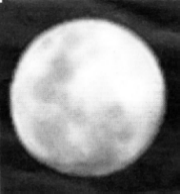
When life was ruled by the light of the silvery moon
DATES OF MEETINGS DECIDED BY THE PHASES OF THE MOON
by THE DIGGER
 |
| A November moon over Lisburn |
AN old friend told me recently about visiting people by bicycle in the district at night during the 1930's or as the expression goes 'many moons ago'.
'We'd go coming up to the full moon," she explained, "but there is hardly a moon mentioned now." The visits were planned to correspond with this part of the lunar cycle. That got me thinking. There are nursery rhymes, stories and songs in existence today making some form of reference to our old lunar friend, but I doubt if there are many of us now who rely on the moon's phases and plan our life accordingly.
Sussex police do. Recent reports stated they had increased patrols on the streets during full moons as they believed the lunar cycle was possibly linked to violent behaviour.
I know people in some of the country districts who can remember various individuals portraying 'strange behaviours' in days gone by as the full moon took its position overhead. Sometimes this behaviour was described among the young horrified onlookers as 'bewitchery' or some- one involved with the 'black art'.
The word 'lunatic' was often used to describe these individuals.
Perhaps there may be some basis to the old belief the moon has the same gravitational effect on human behaviour as it does on oceans - after all we are told we are mostly of aqueous composition.
There may well have been werewolves and other strange creatures out and about in the area when the moon was full but it was more usual to find a group of men travelling by foot or bicycle to a meeting.
I have read local records, spanning from the 1870's to the 1950's, summoning members of various organisations to the next monthly meeting, using the full moon as a marker. I found a copy of the "moon's phases" for 1934 stuck in between the pages of records I examined.
The hours, minutes, and the phases of the moon for each month were carefully detailed, and this information was obviously a necessity for those planning the future monthly meetings.
The comment 'The next meeting to be held on Saturday night on or before the full of the moon' was a commonly used phrase amongst these records.
Various headed notepaper for the different organisations did not only display the standard organisational logo, but included a similar reference to the meeting times: "Meets Saturday evening on or before the lull moon."
The following insertion can be found in The Belfast Newsletter dated October 1863: "Moon's age - last quarter, Monday October 4th at 57 minutes past 6, afternoon."
Those who toiled the fields and worked in agriculture would have been well aware of the moon's waxing and waning phases. The local papers in September 1929 were informing readers there had been 'a particularly good harvester's moon' that year because the full moon fell on the equinox which marked the end of summer and the beginning of Autumn.
Another old friend of mine told me in times past, those people who were 'grafters' would only carry out their grafting techniques during the waxing moon period. It is believed that the sap flowed faster from the stock of the host plant into the graft.
The old customs of turning money in your pockets on seeing the new moon, or when you heard the first cuckoo in spring are probably not practised now, and have been forgotten.
It used to be considered bad luck to sleep with the full moon shining on your face. In order to avoid bad luck children were told to recite 'I see the moon, and the moon sees me. God bless the moon and God bless me' when they had their first glimpse of the new moon.
The sighting of a moon in the leaves of a teacup could have varied fortunes for the tea drinker. A clear full moon shape could indicate some form of romance. The first quarter indicated the opening of new opportunities and the last quarter was regarded as a warning to avoid travel by water or taking up any new undertakings.
I was shown an old handwritten family notebook in the possession of a local family. It dated from 1814 and contained a medley of gems. The author had made an entry dated 10th August 1815 and he or she left us a set of instructions containing 'Directions to find the moon's age'.
"First find the epact which is done by setting down the year of God and dividing it by 19. The remainder multiply by 11.The product divide by 30. The remainder is the epact. Then add the number of the month and day of the month. The months numbered thus: Jan 0, Feb 2, Mar 0, Apr 2, May 2, Jun 4, July 4, Aug 6, Sep 7, Oct 8, Nov 9, Dec 10. If a leap year add one to each month January being excepted."
To assist the reader, the author also meticulously leaves us an example from 1815. This includes a note stating 'the epact one added marks the golden number'.
The golden number is one used to determine the date of Easter from the moon's lunar year cycle.
Anyone who is superstitious should forget about submitting lottery numbers on Friday June 13, 2014. That date corresponds with a full moon.
You'd probably be 'over the moon' winning the lottery but as we all know, a small win may only occur 'once in a blue moon'. Your 'blue moon' may not turn to gold though, as I am told it happens, on average, 37 times every century
Visit the Diggers new web site www.glenavyhistory.com
11/01/2008
